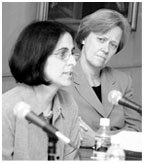
 November
5, 2003:
President's
Page
November
5, 2003:
President's
Page
Women in Science and Engineering
Photo: Virginia Zakian, the Harry C. Wiess, Professor in the Life Sciences, and chair of the Task Force on Women in the Sciences and Engineering, with President Tilghman
Two and a half years ago the presidents of nine major research universities, including Princeton, met at the Massachusetts Institute of Technology to talk about the status of women on their faculties in the sciences and engineering. They were motivated by several concerns, but perhaps the most compelling was our need as universities and a nation to engage the very best minds in addressing the many urgent and complex scientific and engineering challenges of our time. This means that we need to create supportive academic environments that encourage our most talented women as well as men to pursue their educational and scholarly interests in these fields.
At the conference’s close, all nine institutions pledged to make progress toward more inclusion of women in scientific and engineering disciplines. As a professor of molecular biology, I was one of Princeton’s faculty delegates to the conference. In the fall of 2001, as president, I appointed a Task Force on Women in the Sciences and Engineering to take a careful look at our experiences here at Princeton.
The task force, chaired by the Harry C. Wiess Professor in the Life Sciences Virginia Zakian, has just issued its report. Its extensive research included surveys and interviews of current and former faculty members and examination of hiring records, salaries, the rates at which men and women are granted tenure, the allocation of laboratory space and research funding, and other factors. A copy of the report is available online at: www.princeton.edu/pr/reports/sciencetf/.
Among the task force’s encouraging findings is that between 1992 and 2002 the percentage of women faculty members at Princeton in the natural sciences and engineering increased from 8.4 percent to 13.9 percent. The number of women in these departments with tenure more than doubled, and the task force found no differences between male and female faculty in tenure rates or salaries.
While all of this indicates real progress, the task force also identified many respects in which we need to do better. Progress in hiring women was unevenly distributed among our 14 science and engineering departments and the overall numbers of women remain low. Four of the departments had no increase in the representation of women faculty, and my own department, molecular biology, saw its proportion of women actually decline. While nine departments added women to the faculty at rates that approximated or even exceeded the representation of women receiving Ph.D.’s in their fields during the same period, four others appeared to have substantially underutilized the available talent in the last decade. The task force also found that women are underrepresented in departmental leadership positions and that they have lower levels of job satisfaction than men.
By increasing the representation of women on the faculty and in leadership positions and creating a more supportive environment, we may be able to encourage more women students with interests in science and engineering to pursue careers in these fields. Approximately 38 percent of women entering Princeton in the Classes of 2000 through 2003 expressed an intention to major in the sciences and 12 percent expressed an interest in engineering, but by the time they graduated, those percentages dropped to 23 and 9 respectively. Without mentors and role models and clear institutional commitments to provide the conditions necessary for success, women students choose not to aspire to faculty positions in the nation’s leading research universities, including Princeton, thereby depriving us of their talents and perpetuating gender inequities in the sciences and engineering from this generation into the next.
What can we do? Increasing the number of women faculty was the first recommendation of the task force, and they proposed a number of ways to do this. At their suggestion, I appointed Professor Joan Girgus, former chair of the Department of Psychology and former dean of the college, as special assistant to the dean of the faculty to help develop a strategic plan to recruit women faculty and to oversee a range of other projects to improve the climate for women at the University. One way to improve the climate for both male and female faculty is to provide more child care, since balancing family and work was identified by many faculty in the survey as a major impediment to success at Princeton. We are not the only university making these kinds of commitments, but we aim to be one of the most successful.
The task force is right in
insisting that we can and should do better—at Princeton and throughout
higher education— in increasing the representation of women, as students
and as faculty members, in the sciences and engineering. I am grateful
to the task force for clarifying the issues and proposing a blueprint
for a comprehensive and long-term commitment to ensure real opportunity
for women to have successful careers in the sciences and engineering at
Princeton, to our—and society’s—lasting benefit. ![]()
